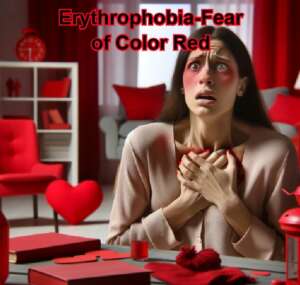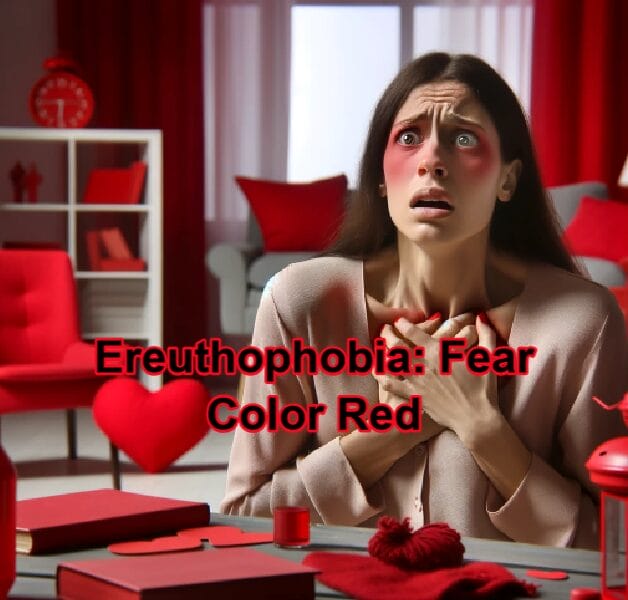Share This Article
Ereuthophobia: Understanding the Fear of the Color Red
Ereuthophobia, or the fear of the color red, is an uncommon but real and often debilitating condition. This phobia can significantly impact a person’s daily life, as the color red is prevalent in many aspects of the environment. Understanding ereuthophobia involves looking at its origins, symptoms, and potential treatments.
What Is Ereuthophobia?
The definition of Ereuthophobia is an intense, excessive and irrational fear of the color red. For those affected, merely seeing red objects or even thinking about the color can provoke anxiety and distress. This phobia falls under the category of specific phobias, which are fears of particular objects or situations.
The fear of red has three technical names: erythrophobia, erytophobia, or ereuthophobia
How May One Develop Ereuthophobia?
The exact cause of ereuthophobia is not entirely understood, but several factors may contribute to its development:
- Traumatic experiences: A person might develop this phobia following a traumatic event associated with the color red, such as an accident or injury where red (like blood) was prominently visible.
- Learned behavior: If someone close, like a parent or sibling, has a strong aversion to red, it might be learned or mimicked.
- Cultural influences: Cultural associations with the color red, such as danger, warning, or aggression, might also play a role.
- Underlying anxiety disorders: People with general anxiety disorders may be more prone to developing specific phobias like ereuthophobia.

A Personal Story
Meet Emma, a 30-year-old graphic designer who developed ereuthophobia after a traumatic car accident when she was a teenager. The car she was in collided with another vehicle, and there was a significant amount of blood at the scene. This traumatic event caused Emma to associate the color red with danger and injury.
For years, Emma found herself unable to work on projects involving the color red. She avoided red clothing, skipped social events like Valentine’s Day parties, and even had trouble shopping for groceries because of red packaging.
Emma’s phobia was affecting her career and personal life. She decided to seek help. Through cognitive behavioral therapy, Emma learned to challenge her negative thoughts about red and gradually exposed herself to the color in controlled settings. Her therapist also taught her relaxation techniques to manage her anxiety.
Slowly, Emma began to reclaim her life. She started incorporating small amounts of red into her design projects and found that over time, her fear diminished. Now, Emma can attend social events and work without the overwhelming dread that used to accompany the sight of red. She still feels a twinge of anxiety now and then, but she has the tools to manage it.
Symptoms of Ereuthophobia
Symptoms of ereuthophobia can vary from person to person but generally include both physical and psychological reactions.
Physical Symptoms
- Rapid heartbeat
- Shortness of breath
- Sweating
- Nausea
- Dizziness
- Trembling or shaking
- Dry mouth
Mental/Emotional Symptoms
- Intense anxiety or panic when seeing the color red
- Avoidance behavior, such as steering clear of places or situations where red is present
- Feelings of dread or terror
- Difficulty concentrating or thinking about anything other than the fear
- Irritability or mood swings
Potential Treatments for Ereuthophobia
Both self-help strategies and professional treatments can be effective in managing ereuthophobia.
Self-Help Strategies
- Gradual exposure: Slowly exposing oneself to the color red in a controlled manner can help desensitize the fear response.
- Relaxation techniques: Practices like deep breathing, meditation, and progressive muscle relaxation can help reduce anxiety.
- Positive associations: Trying to associate the color red with positive memories or experiences may help diminish the fear.
- Support groups: Connecting with others who have similar phobias can provide comfort and practical advice.
Professional Treatments
- Cognitive behavioral therapy (CBT): This therapy focuses on changing the thought patterns that lead to the fear response. A therapist might help the person challenge their irrational thoughts about the color red.
- Exposure therapy: Under the guidance of a therapist, the person is gradually exposed to the color red in a safe environment to lessen the fear over time.
- Medication: In some cases, medications such as anti-anxiety drugs or beta-blockers may be prescribed to help manage severe symptoms.
- Hypnotherapy: This treatment can help address the subconscious mind’s role in the phobia.
In Conclusion
Ereuthophobia, while uncommon, can have a significant impact on a person’s life. Understanding the nature of this fear, its symptoms, and available treatments is crucial for managing and overcoming it. Whether through self-help strategies or professional therapy, individuals with ereuthophobia can learn to cope with their fear and lead fulfilling lives. Emma’s story is a testament to the possibility of recovery and the importance of seeking help when needed.



